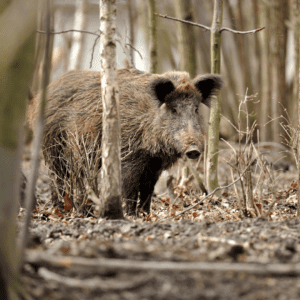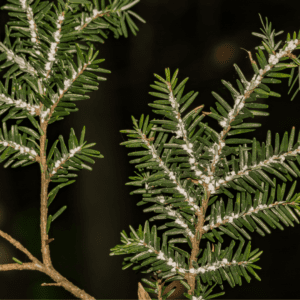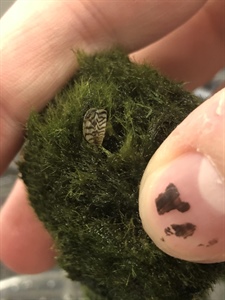Taking Action Against Invasive Wildlife Species in North Carolina – National Invasive Species Awareness Week Blog 2

– Written by Bates Whitaker, NCWF Communications & Marketing Manager
In recognition of National Invasive Species Awareness Week (February 20-26), NCWF is highlighting the top invasive plant and animal species in North Carolina through a two-part blog series and through facilitating ongoing community efforts to address invasive plant species affecting North Carolina wildlife and habitat.
To find out about invasive plant species in North Carolina, check out our companion blog: Taking Action Against Invasive Plants in North Carolina – National Invasive Species Awareness Week Blog 1.
NCWF is committed to protecting wildlife and habitat throughout the state of North Carolina. But what happens when a harmful non-native species is introduced to native North Carolina ecosystems? Why is it such a big deal?
Here’s what you need to know.
What is an invasive species – and why are they such a problem?
An invasive species is any living organism — plant, animal, insect or microbe — that is introduced to an area outside of its original range and causes harm to the environment, the economy, or even human health. Invasive animal species, like invasive plant species, pose significant problems to ecosystem health.
Over the last century, scientists and ecologists such as EO Wilson, Aldo Leopold, and – more recently – Doug Tallamy have drawn comparisons between biological systems and man-made machines. Like a machine, an ecosystem functions at its best when all of its parts function in tandem with one another.
Ecosystems can also be viewed as what Aldo Leopold calls a “land community” or a “biotic community”. Similar to the machine metaphor, ecosystems function like communities, with plant, animal, insect, microbe, and even human members. These communities across the globe have evolved to work together over thousands of years. Over time, the members of such communities have become acquainted with each other and – in one way or another – mutually benefit one another. Symbiotic relationships may not always look friendly – such as in predator and prey dynamics – but the relationship is nevertheless beneficial to the ecosystem, as a whole.
As you can imagine, when one member of a community – or one part of the machine – is removed from its native ecosystem, it is not only adverse for that species but for the ecosystem that it benefits,… hence the significant impacts from species extinction. However, the same may apply when a species is introduced into a community where it has not existed before. When invasive species are introduced, they present a new and unfamiliar dynamic of competition to biological communities and the members within them.

Feral swine are invasive, rooting animals and destroy large swaths of native habitat at a time.
Doug Tallamy, author of Nature’s Best Hope, notes that some critics of this “biotic community” claim that many species have been introduced into ecosystems that were not previously their own, and are now contributing members. Take the numerous species that crossed land bridges to different continents thousands of years ago, for instance. However, Tallamy points out that ecosystems are designed to integrate new members over incredibly long periods of time – thousands or even millions for years. This allows the ecosystem time to adapt to its new members and form a niche for them.
In the past few centuries, we have seen the sudden and dramatic introduction of many invasive species into unprepared biotic communities around the world. And – sadly – North Carolina is not exempt.
Invasive Animal Species in North Carolina

Feral swine
Feral Swine (Sus scrofa):
Feral swine – or invasive wild hogs – are one of the most destructive species to North Carolina habitat. Hogs were released in the 1500s as a fast-producing food source for European settlers, until being managed as a game species during the 1900s, when they saw a tremendous population boom.
Following this population increase, the species began wreaking unprecedented havoc on North Carolina habitat. They are rooting animals known for digging up large swaths of plant life in order to eat roots and underground insects, causing an estimated $1.5 billion dollars in damage per year throughout the United States. Feral swine also prey on ground-nesting bird species and young whitetail deer, and carry many diseases that can be transmitted to people and other wildlife.
The NC Wildlife Resources Commission (NCWRC), as a member of the NC Feral Swine Task Force led by the North Carolina Department of Agriculture (NCDA), is partnering with other agencies in North Carolina to learn more about the ever-increasing issue of invasive feral swine. Please report any feral swine sightings, damage, or kills to the NC Wildlife Helpline at 866-318-2401 or hwi@ncwildlife.org.
Emerald Ash Borer (Agrilus planipennis)

Emerald ash borer
Far smaller than feral swine but also destructive, the emerald ash borer is a metallic green beetle that tunnels through the bark of ash trees to eat the inner tissues beneath the bark, ultimately killing the tree. It was first found in the midwest of the United States, having traveled overseas from Asia in wooden packing materials. As an invasive species, it has rapidly spread across the United States and into North Carolina, leaving tens of millions of dead ash trees in its wake.
Emerald ash borers are a very difficult species to manage, as they are a widespread, flying insect species that can travel up to several miles each year. But perhaps more dangerous is their ability to hide unnoticed in wooden packing materials, subsequently being unintentionally spread by humans across state and even international borders.
Research to manage the beetle is ongoing and the best management plan for now is to minimize its spread while seeking a permanent solution.
Hemlock Wooly Adelgid (Adelges tsugae)

Hemlock wooly adelgid
Hemlock wooly adelgids are aphid-like insects that often evade notice by the average outdoor recreationist, latching onto the needles of hemlock trees and feeding on their branches, preventing the flow of nutrients and causing the needles to weaken and fall off. After becoming infested, hemlocks often die within a few years. This invasive pest originated in Asia and was discovered in the United States in the 1920s and later in the eastern states in the 1950s.
Hemlock wooly adelgids are already a widespread issue but have the potential to become an even larger one, with many scientists anticipating that it could mirror the chestnut blight that decimated the American chestnut in the early 20th century.
Nutria (Myocastor coypus)

Nutria
Nutria – otherwise known as Coypu – are a rodent species from South America brought to the United States in the early 1900s to control harmful plant species. However, over the past century, they have become a significant pest species along the coast of North Carolina.
Similar to beavers, nutria live in swamps and marshes and are voracious eaters, competing with native wildlife for forage. Not only do they feed on native plants, but also on agricultural crops, posing huge issues for coastal farmers. Additionally, they are burrowing animals, often digging their homes into dams and other man-made aquatic structures, posing significant structural damages and safety risks.
Zebra Mussels (Dreissena polymorpha)

Zebra mussel in aquarium moss ball. (Photo credit: NCWRC)
Zebra mussels are one of the most significant and destructive invasive species in North America. Native to Asia, zebra mussels were first detected in the United States in 1988 in the Great Lakes. Despite their small size, they can clog water filtration pipelines, render beaches unusable, and cause damage to watercraft. It is estimated that the United States spends more than $1 billion annually for zebra mussel-related damages.
Unfortunately, zebra mussels have also been detected within a variety of moss ball products designed and sold for use in aquariums and – as such – have continued to work their way into the water system. The moss balls are sold under different brands in a variety of packaging.
Before using moss balls – or any type of aquarium product – it is best practice to inspect them for pests or other harmful elements.
Gill Lice (Salmincola californiensis)

Gill lice (photo credit: Amanda Busho, NCWRC)
Gill lice are a relatively new invasive species to North Carolina but have the potential to continue their spread across the state. Gill lice latch onto the gills of fish and make it difficult for fish to breathe. While many fish are able to tolerate small numbers of gill lice, compounding stressors such as drought and high water temperatures make it harder for some fish to survive these infestations.
Gill lice have recently been found to disproportionately affect native brook trout, having been spread by the illegal stocking of brown and rainbow trout in certain waterways and by fishermen with inadequately cleaned gear.
Because illegal stockings can result in unwanted introductions that can have irreversible consequences, the NCWRC requires a stocking permit to stock any fish into North Carolina’s public waters.
How to Help Manage Invasive Wildlife Species
It can be extraordinarily difficult and costly to control or eradicate invasive plant or animal species once they are established. The best approach to dealing with invasives is to prevent their spread in the first place.
- Learn to identify invasive plants and animals. The NCWRC website has extensive descriptions of both native and invasive wildlife species, providing a crucial resource for the management of harmful non-native species. Additionally, NC Wildlife Federation’s Butterfly Highway Newsletter features a different invasive plant species each week and serves as a great starting point for distinguishing between native and invasive plants.
- Verify that any products – specifically organic materials – are not at risk of spreading invasive species of any kind to new areas. This includes the purchase of firewood, aquarium products, outdoor equipment, and landscaping materials.
- Plant native plants. Though it can be difficult to manage invasive wildlife species on a personal level, you can help care for native wildlife by providing native food and habitat sources, which are decreasing due to the presence of invasive species, habitat fragmentation, and development, among other reasons.. For more information on where you can find native plants, check out this list of statewide native plant nurseries!
- Clean outdoor recreation gear (hiking boots, fishing poles, waders, etc.) after each use.
- Don’t move firewood. If you use firewood, make sure it is from your area and does not pose a risk to native ecosystems.
- Fish with native bait. Using non-native wildlife species as fishing bait may cause the introduction of invasive species into waterways.
- Stay educated. Wildlife management – including invasive species management – is best handled on a large-scale level utilizing state resources and community efforts – including private land owner efforts to manage invasive species. Stay up to date on the latest news surrounding invasive species to find out how you can address these issues in your backyard, and advocate for healthy species management.
North Carolina Wildlife Federation Volunteer Opportunities
Another great way to combat invasive species is by volunteering with the NC Wildlife Federation to help remove invasive plants, plant native species, and educate the public about these issues. You can also check out the Bradford Pear Bounty Program, a collaborative effort between NC Wildlife Federation, NC Urban Forest Council, the NC State Extension and the NC Forest Service. Spring is a great time for planting! NCWF and our local community wildlife chapters have a lot of planting, invasive species removing, and native plant educating events in the works, so please check the NCWF Calendar frequently for the latest updates!




